Abstract
The effect of olsalazine, an analogue of sulphasalazine, consisting of two molecules 5-aminosalicylic acid linked by an azobond has been investigated for the treatment of ulcerative colitis. In a randomised double blind trial we compared 2 g olsalazine with placebo for four weeks. Of the 105 patients, with mild to moderate ulcerative colitis, entered in the trial 52 received olsalazine, and 53 placebo. Treatment had to be terminated prematurely because of untoward effects of olsalazine (mainly diarrhoea) in three patients and treatment failure--that is, increased rectal bleeding in four patients (olsalazine group: one placebo group: three). After four weeks' treatment, a statistically significant improvement in the endoscopic findings in rectum and a positive trend in the reduction of rectal mucus and blood discharge was observed in the patients treated with olsalazine. No statistically significant difference was found for other factors, including stool frequency, consistency, urge to defecate, abdominal pain, and biopsy findings. A comparison between these clinical and endoscopic parameters at study entry and those at study completion (within drug evaluation) showed significant improvement in six of 10 parameters during treatment with olsalazine and in two of 10 during placebo treatment. This difference suggests the significant effect of olsalazine. We conclude that 2 g olsalazine was tolerated as well as placebo, apart from causing diarrhoea in some patients and was slightly superior to placebo during four weeks' treatment of mild to moderate ulcerative colitis. A study with 3 or 4 g olsalazine per day may show a more definite effect.
Full text
PDF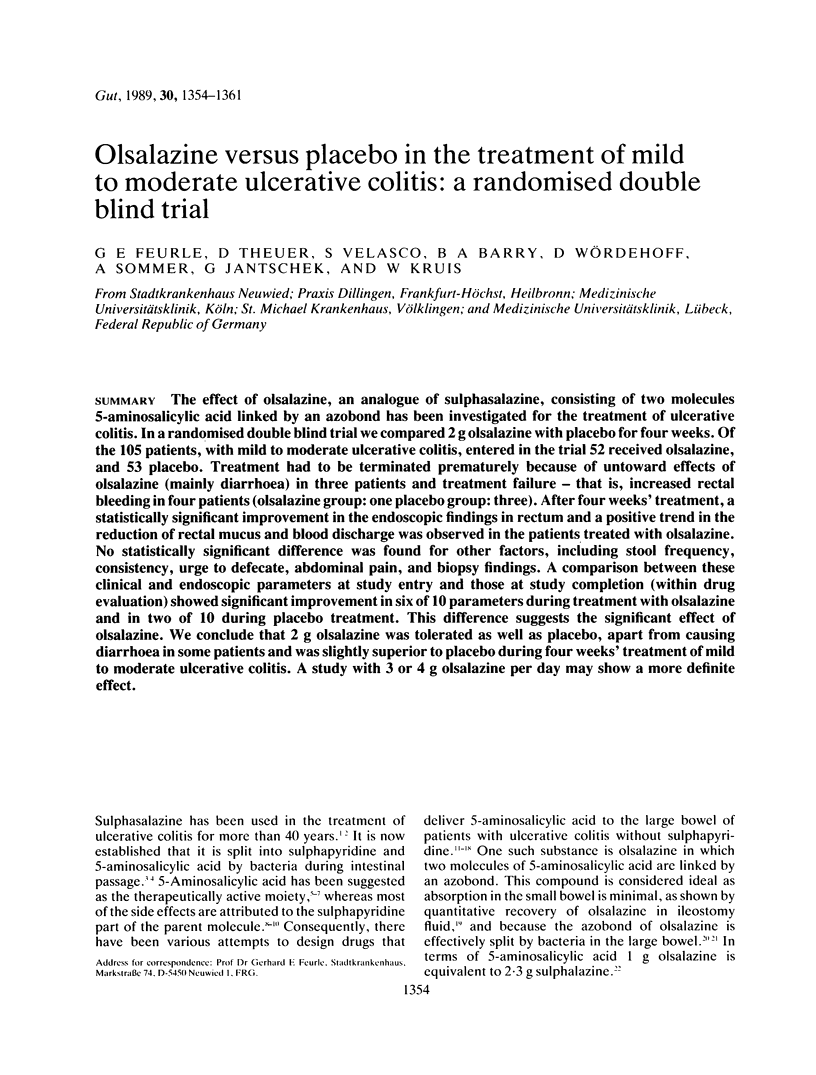

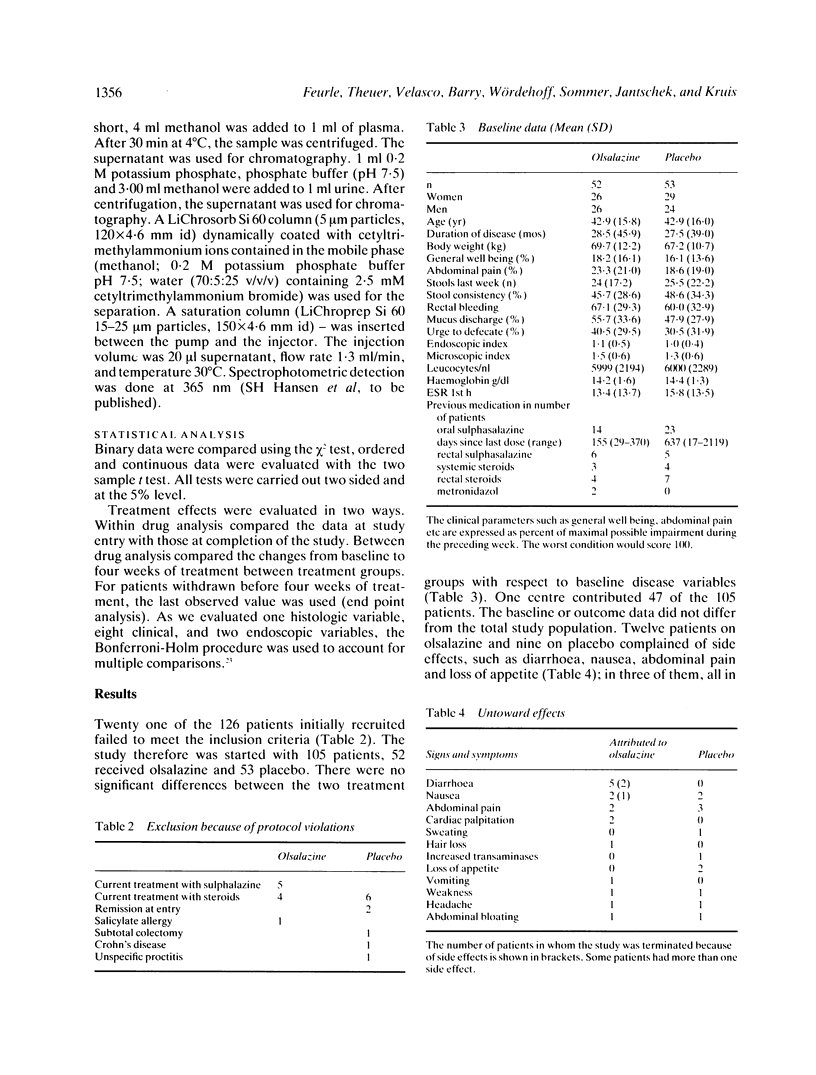
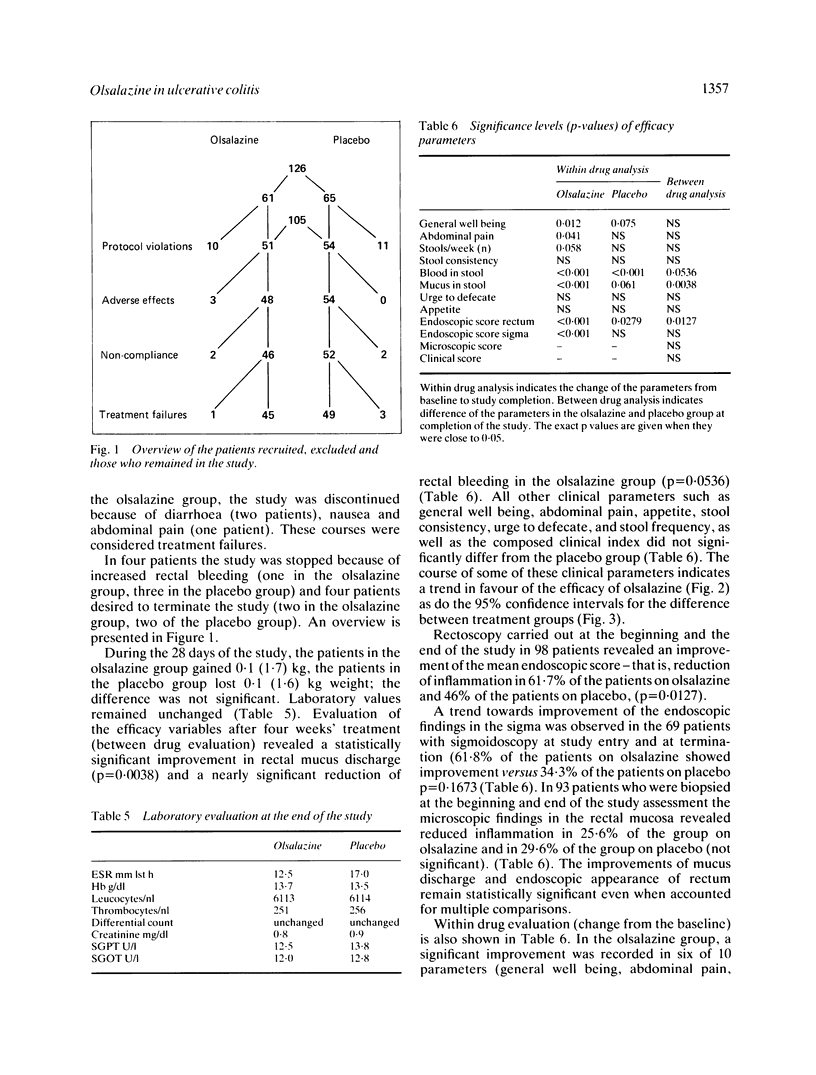


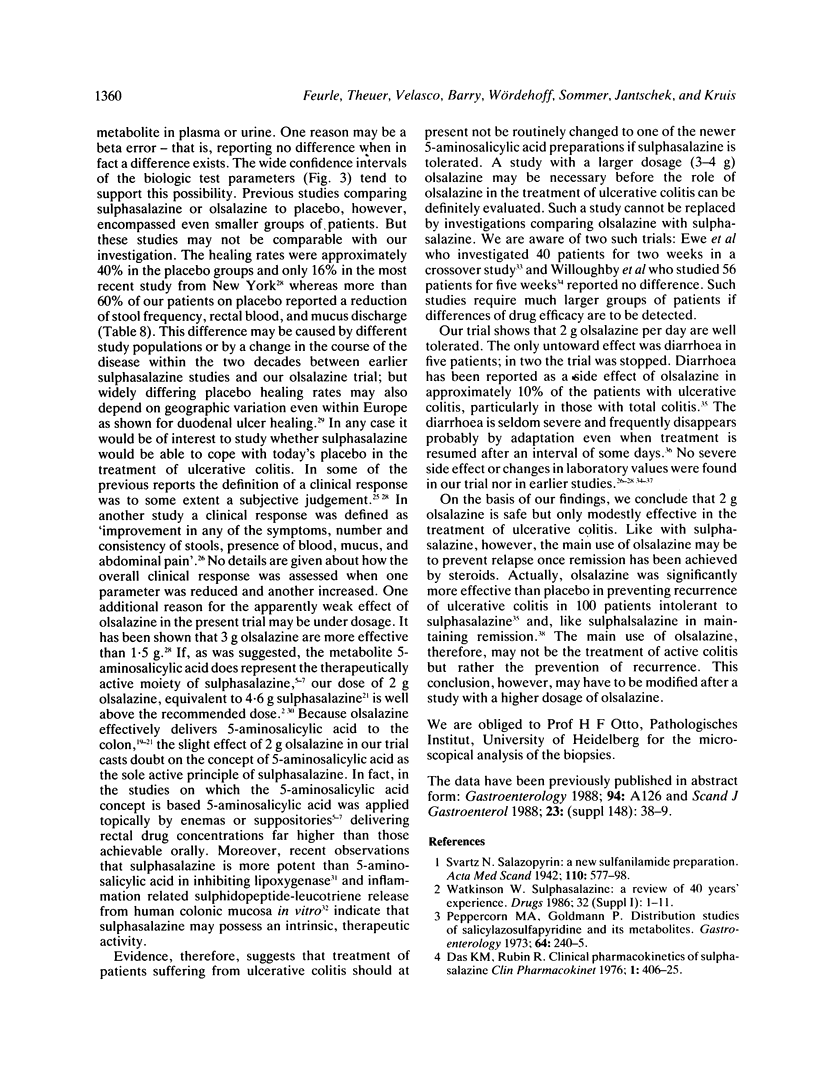
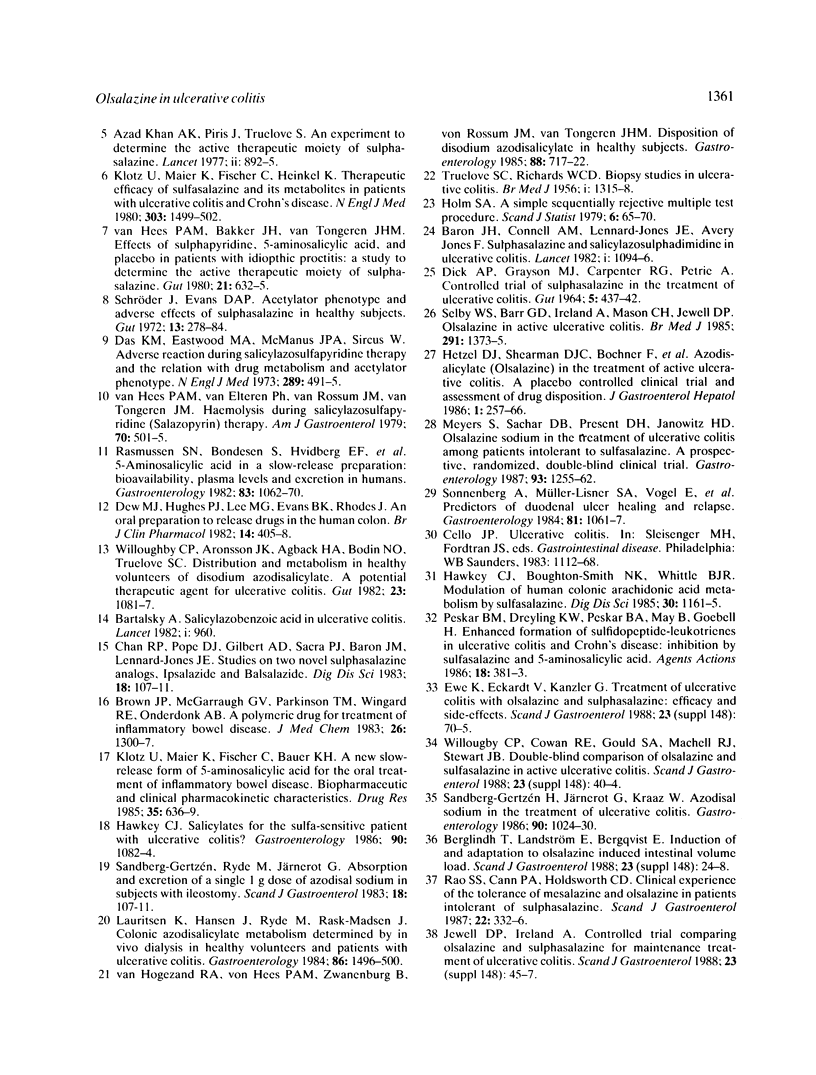
Selected References
These references are in PubMed. This may not be the complete list of references from this article.
- Azad Khan A. K., Piris J., Truelove S. C. An experiment to determine the active therapeutic moiety of sulphasalazine. Lancet. 1977 Oct 29;2(8044):892–895. doi: 10.1016/s0140-6736(77)90831-5. [DOI] [PubMed] [Google Scholar]
- BARON J. H., CONNELL A. M., LENNARD-JONES J. E., JONES F. A. Sulphasalazine and salicylazosulphadimidine in ulcerative colitis. Lancet. 1962 May 26;1(7239):1094–1096. doi: 10.1016/s0140-6736(62)92080-9. [DOI] [PubMed] [Google Scholar]
- Bartalsky A. Salicylazobenzoic acid in ulcerative colitis. Lancet. 1982 Apr 24;1(8278):960–960. doi: 10.1016/s0140-6736(82)91956-0. [DOI] [PubMed] [Google Scholar]
- Berglindh T., Landström E., Bergqvist E. Induction of and adaptation to olsalazine induced intestinal volume load. Scand J Gastroenterol Suppl. 1988;148:24–28. doi: 10.3109/00365528809101543. [DOI] [PubMed] [Google Scholar]
- Brown J. P., McGarraugh G. V., Parkinson T. M., Wingard R. E., Jr, Onderdonk A. B. A polymeric drug for treatment of inflammatory bowel disease. J Med Chem. 1983 Sep;26(9):1300–1307. doi: 10.1021/jm00363a015. [DOI] [PubMed] [Google Scholar]
- DICK A. P., GRAYSON M. J., CARPENTER R. G., PETRIE A. CONTROLLED TRIAL OF SULPHASALAZINE IN THE TREATMENT OF ULCERATIVE COLITIS. Gut. 1964 Oct;5:437–442. doi: 10.1136/gut.5.5.437. [DOI] [PMC free article] [PubMed] [Google Scholar]
- Das K. M., Dubin R. Clinical pharmacokinetics of sulphasalazine. Clin Pharmacokinet. 1976 Nov-Dec;1(6):406–425. doi: 10.2165/00003088-197601060-00002. [DOI] [PubMed] [Google Scholar]
- Das K. M., Eastwood M. A., McManus J. P., Sircus W. Adverse reactions during salicylazosulfapyridine therapy and the relation with drug metabolism and acetylator phenotype. N Engl J Med. 1973 Sep 6;289(10):491–495. doi: 10.1056/NEJM197309062891001. [DOI] [PubMed] [Google Scholar]
- Dew M. J., Hughes P. J., Lee M. G., Evans B. K., Rhodes J. An oral preparation to release drugs in the human colon. Br J Clin Pharmacol. 1982 Sep;14(3):405–408. doi: 10.1111/j.1365-2125.1982.tb01999.x. [DOI] [PMC free article] [PubMed] [Google Scholar]
- Ewe K., Eckardt V., Kanzler G. Treatment of ulcerative colitis with olsalazine and sulphasalazine: efficacy and side-effects. Scand J Gastroenterol Suppl. 1988;148:70–75. doi: 10.3109/00365528809101553. [DOI] [PubMed] [Google Scholar]
- Hawkey C. J., Boughton-Smith N. K., Whittle B. J. Modulation of human colonic arachidonic acid metabolism by sulfasalazine. Dig Dis Sci. 1985 Dec;30(12):1161–1165. doi: 10.1007/BF01314051. [DOI] [PubMed] [Google Scholar]
- Hawkey C. J. Salicylates for the sulfa-sensitive patient with ulcerative colitis? Gastroenterology. 1986 Apr;90(4):1082–1084. doi: 10.1016/0016-5085(86)90890-5. [DOI] [PubMed] [Google Scholar]
- Jewell D. P., Ireland A. Controlled trial comparing olsalazine and sulphasalazine for maintenance treatment of ulcerative colitis. Scand J Gastroenterol Suppl. 1988;148:45–47. doi: 10.3109/00365528809101547. [DOI] [PubMed] [Google Scholar]
- Klotz U., Maier K. E., Fischer C., Bauer K. H. A new slow-release form of 5-aminosalicylic acid for the oral treatment of inflammatory bowel disease. Biopharmaceutic and clinical pharmacokinetic characteristics. Arzneimittelforschung. 1985;35(3):636–639. [PubMed] [Google Scholar]
- Klotz U., Maier K., Fischer C., Heinkel K. Therapeutic efficacy of sulfasalazine and its metabolites in patients with ulcerative colitis and Crohn's disease. N Engl J Med. 1980 Dec 25;303(26):1499–1502. doi: 10.1056/NEJM198012253032602. [DOI] [PubMed] [Google Scholar]
- Lauritsen K., Hansen J., Ryde M., Rask-Madsen J. Colonic azodisalicylate metabolism determined by in vivo dialysis in healthy volunteers and patients with ulcerative colitis. Gastroenterology. 1984 Jun;86(6):1496–1500. [PubMed] [Google Scholar]
- Meyers S., Sachar D. B., Present D. H., Janowitz H. D. Olsalazine sodium in the treatment of ulcerative colitis among patients intolerant of sulfasalazine. A prospective, randomized, placebo-controlled, double-blind, dose-ranging clinical trial. Gastroenterology. 1987 Dec;93(6):1255–1262. doi: 10.1016/0016-5085(87)90253-8. [DOI] [PubMed] [Google Scholar]
- Peppercorn M. A., Goldman P. Distribution studies of salicylazosulfapyridine and its metabolites. Gastroenterology. 1973 Feb;64(2):240–245. [PubMed] [Google Scholar]
- Peskar B. M., Dreyling K. W., Peskar B. A., May B., Goebell H. Enhanced formation of sulfidopeptide-leukotrienes in ulcerative colitis and Crohn's disease: inhibition by sulfasalazine and 5-aminosalicylic acid. Agents Actions. 1986 Jun;18(3-4):381–383. doi: 10.1007/BF01965001. [DOI] [PubMed] [Google Scholar]
- Rao S. S., Cann P. A., Holdsworth C. D. Clinical experience of the tolerance of mesalazine and olsalazine in patients intolerant of sulphasalazine. Scand J Gastroenterol. 1987 Apr;22(3):332–336. doi: 10.3109/00365528709078600. [DOI] [PubMed] [Google Scholar]
- Rasmussen S. N., Bondesen S., Hvidberg E. F., Hansen S. H., Binder V., Halskov S., Flachs H. 5-aminosalicylic acid in a slow-release preparation: bioavailability, plasma level, and excretion in humans. Gastroenterology. 1982 Nov;83(5):1062–1070. [PubMed] [Google Scholar]
- Sandberg-Gertzén H., Järnerot G., Kraaz W. Azodisal sodium in the treatment of ulcerative colitis. A study of tolerance and relapse-prevention properties. Gastroenterology. 1986 Apr;90(4):1024–1030. doi: 10.1016/0016-5085(86)90882-6. [DOI] [PubMed] [Google Scholar]
- Sandberg-Gertzén H., Ryde M., Järnerot G. Absorption and excretion of a single 1-g dose of azodisal sodium in subjects with ileostomy. Scand J Gastroenterol. 1983 Jan;18(1):107–111. doi: 10.3109/00365528309181568. [DOI] [PubMed] [Google Scholar]
- Schröder H., Evans D. A. Acetylator phenotype and adverse effects of sulphasalazine in healthy subjects. Gut. 1972 Apr;13(4):278–284. doi: 10.1136/gut.13.4.278. [DOI] [PMC free article] [PubMed] [Google Scholar]
- Selby W. S., Barr G. D., Ireland A., Mason C. H., Jewell D. P. Olsalazine in active ulcerative colitis. Br Med J (Clin Res Ed) 1985 Nov 16;291(6506):1373–1375. doi: 10.1136/bmj.291.6506.1373. [DOI] [PMC free article] [PubMed] [Google Scholar]
- Sonnenberg A., Müller-Lissner S. A., Vogel E., Schmid P., Gonvers J. J., Peter P., Strohmeyer G., Blum A. L. Predictors of duodenal ulcer healing and relapse. Gastroenterology. 1981 Dec;81(6):1061–1067. [PubMed] [Google Scholar]
- TRUELOVE S. C., RICHARDS W. C. Biopsy studies in ulcerative colitis. Br Med J. 1956 Jun 9;1(4979):1315–1318. doi: 10.1136/bmj.1.4979.1315. [DOI] [PMC free article] [PubMed] [Google Scholar]
- Watkinson G. Sulphasalazine: a review of 40 years' experience. Drugs. 1986;32 (Suppl 1):1–11. doi: 10.2165/00003495-198600321-00003. [DOI] [PubMed] [Google Scholar]
- Willoughby C. P., Aronson J. K., Agback H., Bodin N. O., Truelove S. C. Distribution and metabolism in healthy volunteers of disodium azodisalicylate, a potential therapeutic agent for ulcerative colitis. Gut. 1982 Dec;23(12):1081–1087. doi: 10.1136/gut.23.12.1081. [DOI] [PMC free article] [PubMed] [Google Scholar]
- Willoughby C. P., Cowan R. E., Gould S. R., Machell R. J., Stewart J. B. Double-blind comparison of olsalazine and sulphasalazine in active ulcerative colitis. Scand J Gastroenterol Suppl. 1988;148:40–44. doi: 10.3109/00365528809101546. [DOI] [PubMed] [Google Scholar]
- van Hees P. A., Bakker J. H., van Tongeren J. H. Effect of sulphapyridine, 5-aminosalicylic acid, and placebo in patients with idiopathic proctitis: a study to determine the active therapeutic moiety of sulphasalazine. Gut. 1980 Jul;21(7):632–635. doi: 10.1136/gut.21.7.632. [DOI] [PMC free article] [PubMed] [Google Scholar]
- van Hees P. A., van Elferen L. W., van Rossum J. M., van Tongeren J. H. Hemolysis during salicylazosulfapyridine therapy. Am J Gastroenterol. 1978 Nov;70(5):501–505. [PubMed] [Google Scholar]
- van Hogezand R. A., van Hees P. A., Zwanenburg B., van Rossum J. M., van Tongeren J. H. Disposition of disodium azodisalicylate in healthy subjects. A possible new drug for inflammatory bowel disease. Gastroenterology. 1985 Mar;88(3):717–722. doi: 10.1016/0016-5085(85)90142-8. [DOI] [PubMed] [Google Scholar]


